Cu(C3H3N3S3)3 Adsorption onto ZnTiO3/TiO2 for Coordination-Complex Sensitized Photochemical Applications
Abstract
1. Introduction
2. Materials and Methods
2.1. Materials
2.2. Synthesis of ZnTiO3/TiO2 (ZTO/TO)
2.3. Synthesis of Cu(C3H3N3S3)3 (Cu-TTC)
2.4. Synthesis of Cu-TTC/ZTO/TO Composite
2.5. Characterization of Cu-TTC/ZTO/TO Composite
2.6. Photocatalytic Activity
2.7. Computational Calculations
3. Results
3.1. Characterization of the Samples
3.1.1. XRD Analysis
3.1.2. UV-Vis Spectroscopy
3.2. Photocatalytic Activity
3.3. Computational Calculations
3.3.1. Optimization of the Cu-TTC Structure
3.3.2. Frontier Molecular Orbitals (HOMO-LUMO) of the Cu-TTC Structure
3.3.3. Molecular Electrostatic Potential of the Cu-TTC Structure
3.3.4. Adsorption of the Cu-TTC on the ZnTiO3 (ZTO) and TiO2 (TO) Surfaces
4. Discussion
4.1. Characterization of the Samples
4.1.1. XRD Analysis
4.1.2. UV-Vis Spectroscopy
4.2. Photocatalytic Activity
4.3. Computational Calculations
5. Conclusions
Supplementary Materials
Author Contributions
Funding
Institutional Review Board Statement
Informed Consent Statement
Data Availability Statement
Acknowledgments
Conflicts of Interest
References
- Cavallaro, G.; Lazzara, G.; Rozhina, E.; Konnova, S.; Kryuchkova, M.; Khaertdinov, N.; Fakhrullin, R. Organic-nanoclay composite materials as removal agents for environmental decontamination. RSC Adv. 2019, 9, 40553–40564. [Google Scholar] [CrossRef]
- Lu, F.; Astruc, D. Nanocatalysts and other nanomaterials for water remediation from organic pollutants. Coord. Chem. Rev. 2020, 408, 213180. [Google Scholar] [CrossRef]
- Khan, I.; Saeed, K.; Zekker, I.; Zhang, B.; Hendi, A.H.; Ahmad, A.; Ahmad, S.; Zada, N.; Ahmad, H.; Shah, L.A.; et al. Review on Methylene Blue: Its Properties, Uses, Toxicity and Photodegradation. Water 2022, 14, 242. [Google Scholar] [CrossRef]
- Abirami, R.; Kalaiselvi, C.; Kungumadevi, L.; Senthil, T.; Kang, M. Synthesis and characterization of ZnTiO3 and Ag doped ZnTiO3 perovskite nanoparticles and their enhanced photocatalytic and antibacterial activity. J. Solid State Chem. 2019, 281, 121019. [Google Scholar] [CrossRef]
- Siwińska-Stefańska, K.; Kubiak, A.; Piasecki, A.; Goscianska, J.; Nowaczyk, G.; Jurga, S.; Jesionowski, T. TiO2-ZnO Binary Oxide Systems: Comprehensive Characterization and Tests of Photocatalytic Activity. Materials 2018, 11, 841. [Google Scholar] [CrossRef] [PubMed]
- Karthikeyan, C.; Arunachalam, P.; Ramachandran, K.; Al-Mayouf, A.M.; Karuppuchamy, S. Recent advances in semiconductor metal oxides with enhanced methods for solar photocatalytic applications. J. Alloy. Compd. 2020, 828, 154281. [Google Scholar] [CrossRef]
- Gnanaseelan, N.; Latha, M.; Mantilla, A.; Sathish-Kumar, K.; Caballero-Briones, F. The role of redox states and junctions in photocatalytic hydrogen generation of MoS2-TiO2-rGO and CeO2-Ce2Ti3O8.7-TiO2-rGO composites. Mater. Sci. Semicond. Process. 2020, 118, 105185. [Google Scholar] [CrossRef]
- Mofokeng, S.; Noto, L.; Kroon, R.; Ntwaeaborwa, O.; Dhlamini, M. Up-conversion luminescence and energy transfer mechanism in ZnTiO3: Er3+, Yb3+ phosphor. J. Lumin. 2020, 223, 117192. [Google Scholar] [CrossRef]
- Ranjith, K.S.; Uyar, T. ZnO–TiO2 composites and ternary ZnTiO3 electrospun nanofibers: The influence of annealing on the photocatalytic response and reusable functionality. CrystEngComm 2018, 20, 5801–5813. [Google Scholar] [CrossRef]
- Surynek, M.; Spanhel, L.; Lapcik, L.; Mrazek, J. Tuning the photocatalytic properties of sol–gel-derived single, coupled, and alloyed ZnO–TiO2 nanoparticles. Res. Chem. Intermed. 2019, 45, 4193–4204. [Google Scholar] [CrossRef]
- Chen, M.; Jafvert, C.T.; Wu, Y.; Cao, X.; Hankins, N.P. Inorganic anion removal using micellar enhanced ultrafiltration (MEUF), modeling anion distribution and suggested improvements of MEUF: A review. Chem. Eng. J. 2020, 398, 125413. [Google Scholar] [CrossRef]
- Faisal, M.; Jalalah, M.; Harraz, F.A.; El-Toni, A.M.; Labis, J.P.; Al-Assiri, M. A novel Ag/PANI/ZnTiO3 ternary nanocomposite as a highly efficient visible-light-driven photocatalyst. Sep. Purif. Technol. 2020, 256, 117847. [Google Scholar] [CrossRef]
- Zalani, N.M.; Kaleji, B.K.; Mazinani, B. Synthesis and characterisation of the mesoporous ZnO-TiO2 nanocomposite; Taguchi optimisation and photocatalytic methylene blue degradation under visible light. Mater. Technol. 2019, 35, 281–289. [Google Scholar] [CrossRef]
- Chuaicham, C.; Karthikeyan, S.; Song, J.T.; Ishihara, T.; Ohtani, B.; Sasaki, K. Importance of ZnTiO3 Phase in ZnTi-Mixed Metal Oxide Photocatalysts Derived from Layered Double Hydroxide. ACS Appl. Mater. Interfaces 2020, 12, 9169–9180. [Google Scholar] [CrossRef]
- Li, X.; Xiong, J.; Huang, J.; Feng, Z.; Luo, J. Novel g-C3N4/h′ZnTiO3-a′TiO2 direct Z-scheme heterojunction with significantly enhanced visible-light photocatalytic activity. J. Alloy. Compd. 2018, 774, 768–778. [Google Scholar] [CrossRef]
- Wattanawikkam, C.; Kansa-Ard, T.; Pecharapa, W. X-ray absorption spectroscopy analysis and photocatalytic behavior of ZnTiO3 nanoparticles doped with Co and Mn synthesized by sonochemical method. Appl. Surf. Sci. 2019, 474, 169–176. [Google Scholar] [CrossRef]
- Baamran, K.S.; Tahir, M. Ni-embedded TiO2-ZnTiO3 reducible perovskite composite with synergistic effect of metal/support towards enhanced H2 production via phenol steam reforming. Energy Convers. Manag. 2019, 200, 112064. [Google Scholar] [CrossRef]
- Al-Hajji, L. A Comparative Study on the Zinc Metatitanate Microstructure by Ball Milling and Solvothermal Approaches. J. Struct. Chem. 2019, 60, 830–837. [Google Scholar] [CrossRef]
- Bhagwat, U.O.; Wu, J.J.; Asiri, A.M.; Anandan, S. Synthesis of ZnTiO 3 @TiO 2 Heterostructure Nanomaterial as a Visible light Photocatalyst. ChemistrySelect 2019, 4, 6106–6112. [Google Scholar] [CrossRef]
- Sarkar, M.; Sarkar, S.; Biswas, A.; De, S.; Kumar, P.R.; Mothi, E.M.; Kathiravan, A. Zinc titanate nanomaterials—Photocatalytic studies and sensitization of hydantoin derivatized porphyrin dye. Nano-Struct. Nano-Objects 2019, 21, 100412. [Google Scholar] [CrossRef]
- An, M.; Li, L.; Wu, Q.; Yu, H.; Gao, X.; Zu, W.; Guan, J.; Yu, Y. CdS QDs modified three-dimensional ordered hollow spherical ZnTiO3-ZnO-TiO2 composite with improved photocatalytic performance. J. Alloy. Compd. 2021, 895, 162638. [Google Scholar] [CrossRef]
- Bhogaita, M.; Devaprakasam, D. Hybrid photoanode of TiO2-ZnO synthesized by co-precipitation route for dye-sensitized solar cell using phyllanthus reticulatas pigment sensitizer. Sol. Energy 2020, 214, 517–530. [Google Scholar] [CrossRef]
- Sinha, D.; De, D.; Goswami, D.; Mondal, A.; Ayaz, A. ZnO and TiO2 Nanostructured Dye sensitized Solar Photovoltaic Cell. Mater. Today Proc. 2019, 11, 782–788. [Google Scholar] [CrossRef]
- Sanchez, H.; Esparza, D.; Lopez-Luke, T.; Castañeda-Contreras, J.; Marañon-Ruiz, V.; Zarazúa, I.; Rodriguez, R. Effect of Al3+ doping concentration and film thickness of ZnO nanoparticles over the TiO2 photoelectrode in CdS quantum dots sensitized solar cells. Sol. Energy 2020, 197, 154–162. [Google Scholar] [CrossRef]
- Apell, J.N.; McNeill, K. Updated and validated solar irradiance reference spectra for estimating environmental photodegradation rates. Environ. Sci. Process. Impacts 2019, 21, 427–437. [Google Scholar] [CrossRef]
- Khaki, M.R.D.; Shafeeyan, M.S.; Raman, A.A.A.; Daud, W.M.A.W. Enhanced UV–Visible photocatalytic activity of Cu-doped ZnO/TiO2 nanoparticles. J. Mater. Sci. Mater. Electron. 2018, 29, 5480–5495. [Google Scholar] [CrossRef]
- Upadhyay, G.K.; Rajput, J.K.; Pathak, T.K.; Kumar, V.; Purohit, L. Synthesis of ZnO:TiO2 nanocomposites for photocatalyst application in visible light. Vacuum 2018, 160, 154–163. [Google Scholar] [CrossRef]
- Liu, Y.; Yang, A.-A.; Wang, Y.; Li, W.-Z.; Zhang, X.-S.; Luan, J.; Liu, H.-Z.; Wang, Z.-G. Synthesis of two polymorphic Cu-based coordination polymers of 1,2,4-benzenetricarboxylic acid along with a carbon-coated composite for the selective degradation of organic dyes. J. Solid State Chem. 2021, 303, 122506. [Google Scholar] [CrossRef]
- Khang, K.C.L.; Hatta, M.H.M.; Lee, S.L.; Yuliati, L. Photocatalytic removal of phenol over mesoporous ZnO/TiO2 composites. J. Teknol. 2018, 80, 153–160. [Google Scholar] [CrossRef][Green Version]
- Sandoya, V.; Saura-Mas, S.; la Cerda, I.G.-D.; Arellano, G.; Macía, M.J.; Tello, J.S.; Lloret, F. Contribution of species abundance and frequency to aboveground forest biomass along an Andean elevation gradient. For. Ecol. Manag. 2020, 479, 118549. [Google Scholar] [CrossRef]
- Matsushita, S.; Tsuruoka, A.; Kimura, Y.; Isobe, T.; Nakajima, A. Influence of semiconductor crystallinity on a β-FeSi2 sensitized thermal cell. Solid-state Electron. 2019, 158, 70–74. [Google Scholar] [CrossRef]
- Su, L.; Hong, T.; Wang, D.; Wang, S.; Qin, B.; Zhang, M.; Gao, X.; Chang, C.; Zhao, L.-D. Realizing high doping efficiency and thermoelectric performance in n-type SnSe polycrystals via bandgap engineering and vacancy compensation. Mater. Today Phys. 2021, 20, 100452. [Google Scholar] [CrossRef]
- Chakraborty, A.; Debnath, G.H.; Mukherjee, P. Maximizing dopant photoluminescence in co-doped semiconductor nanoparticles for multiplex assays by tuning inter dopant electronic interactions: Synthetic co-doping or physical mixing of singly doped moieties? J. Lumin. 2018, 203, 257–266. [Google Scholar] [CrossRef]
- Cherifi, K.; Cheknane, A.S.; Hilal, H.; Benghia, A.; Rahmoun, K.; Benyoucef, B. Investigation of triphenylamine-based sensitizer characteristics and adsorption behavior onto ZnTiO3 perovskite (1 0 1) surfaces for dye-sensitized solar cells using first-principle calculation. Chem. Phys. 2019, 530, 110595. [Google Scholar] [CrossRef]
- Xu, W.; Wang, J.; Yu, H.; Liu, P.; Zhang, G.-R.; Huang, H.; Mei, D. Size-dependent electron injection over sensitized semiconductor heterojunctions for enhanced photocatalytic hydrogen production. Appl. Catal. B Environ. 2022, 308, 121218. [Google Scholar] [CrossRef]
- Hamidian, K.; Rahimi, R.; Hosseini-Kharat, M.; Alavi, M. Development of the molecular engineering of disazo dye sensitizers and TiO2 semiconductor surface to improve the power conversion efficiency of dye-sensitized solar cells. J. Photochem. Photobiol. A Chem. 2021, 418, 113408. [Google Scholar] [CrossRef]
- Rahmalia, W.; Septiani, S.; Naselia, U.A.; Usman, T.; Silalahi, I.H.; Mouloungui, Z. Performance Improvements of Bixin and Metal-Bixin Complexes Sensitized Solar Cells by 1-Methyl-3-propylimidazolium Iodide in Electrolyte System. Indones. J. Chem. 2021, 21, 669–678. [Google Scholar] [CrossRef]
- Kuganathan, N.; Chroneos, A. Hydrogen Adsorption on Ru-Encapsulated, -Doped and -Supported Surfaces of C60. Surfaces 2020, 3, 408–422. [Google Scholar] [CrossRef]
- Cherifi, K.; Cheknane, A.; Benghia, A.; Hilal, H.S.; Rahmoun, K.; Benyoucef, B.; Goumri-Said, S. Exploring N3 ruthenium dye adsorption onto ZnTiO3 (101) and (110) surfaces for dye sensitized solar cell applications: Full computational study. Mater. Today Energy 2019, 13, 109–118. [Google Scholar] [CrossRef]
- Daoud, A.; Cheknane, A.; Hilal, H.S.; Meftah, A.; Benghia, A. Simulation of electronic and optical properties of polyene-diphenylaniline-sensitizers for perovskite n-ZnTiO3 towards efficient dye sensitized solar cells. Mater. Sci. Semicond. Process. 2021, 134, 106037. [Google Scholar] [CrossRef]
- Abeysingha, S.N.; Wijesundera, R.P.; Hettiarachchi, C.V.; Perera, I.R. Zn based 3D-Coordination polymer as the photoanode material in dye-sensitized solar cells. Mater. Chem. Phys. 2020, 251, 123109. [Google Scholar] [CrossRef]
- Fan, K.; Zhang, C.; Chen, Y.; Wu, Y.; Wang, C. The chemical states of conjugated coordination polymers. Chem 2020, 7, 1224–1243. [Google Scholar] [CrossRef]
- Inci, D.; Aydın, R.; Zorlu, Y. NOO-type tridentate Schiff base ligand and its one-dimensional Cu(II) coordination polymer: Synthesis, crystal structure, biomacromolecular interactions and radical scavenging activities. Inorg. Chim. Acta 2020, 514, 119994. [Google Scholar] [CrossRef]
- Liu, X.-X.; Lu, L.-P.; Zhu, M.-L. Design and synthesis of a stable multifunctional photoluminescence sensing material for rare earth ions from a 2D undulating Cd-coordination polymer. Sensors Actuators B Chem. 2021, 347, 130641. [Google Scholar] [CrossRef]
- Chatterjee, T.; Dutta, B.; Roy, R.; Siddiqui, M.R.; Wabaidur, S.M.; Islam, A.; Ahmed, F.; Alam, S.M.; Mir, M.H. Synthesis, characterization and exploration of supramolecular interactions of a Cu(II) based 1D zig-zag coordination polymer: X-ray structure determination and DFT study. Inorg. Chim. Acta 2022, 536, 120894. [Google Scholar] [CrossRef]
- Tay, H.M.; Kyratzis, N.; Thoonen, S.; Boer, S.A.; Turner, D.R.; Hua, C. Synthetic strategies towards chiral coordination polymers. Coord. Chem. Rev. 2021, 435, 213763. [Google Scholar] [CrossRef]
- Suku, S.; Ravindran, R. Synthesis, characterization and antimicrobial studies of 1d hetero-bimetallic coordination polymers of pyridine-2,6-dicarboxylic acid with iron and alkaline earth metals. J. Mol. Struct. 2021, 132083. [Google Scholar] [CrossRef]
- Laachir, A.; Zine, H.; Guesmi, S.; Ketatni, E.M.; Saadi, M.; El Ammari, L.; Mentré, O.; Bentiss, F. Unusual mixed-valence CuII/CuI coordination polymer based on 2,5-bis(pyridine-2-yl)-1,3,4-thiadiazole and thiocyanate: Synthesis, structural characterization and antimicrobial in vitro activity assessment. Polyhedron 2021, 209, 115494. [Google Scholar] [CrossRef]
- Jaramillo-Fierro, X.V.; Zambrano, C.; Fernández, F.; Saenz-Puche, R.; Costa, C.; Guerrero, V.; Gonzalez, S. Synthesis, characterization and theoretical calculations of Cu(I) complex of trithiocyanuric acid [Cu(ttc)3]. Univ. Sci. 2018, 23, 241–266. [Google Scholar] [CrossRef]
- Ashrafi, A.M.; Kopel, P.; Richtera, L. An Investigation on the Electrochemical Behavior and Antibacterial and Cytotoxic Activity of Nickel Trithiocyanurate Complexes. Materials 2020, 13, 1782. [Google Scholar] [CrossRef]
- Lobana, T.S. Heterocyclic-2-thione derivatives of group 10–12 metals: Coordination versatility, activation of C S (thione) bonds and biochemical potential. Coord. Chem. Rev. 2021, 441, 213884. [Google Scholar] [CrossRef]
- Fu, W.; Wang, X.; Huang, Z. Remarkable reusability of magnetic Fe3O4-encapsulated C3N3S3 polymer/reduced graphene oxide composite: A highly effective adsorbent for Pb and Hg ions. Sci. Total Environ. 2019, 659, 895–904. [Google Scholar] [CrossRef] [PubMed]
- Yan, C.; Dong, X.; Wang, Y.; Zheng, N.; Dang, H.; Ma, H.; Zhang, X. Porous Cd3(C3N3S3)2/CdS composites with outstanding Cr(VI) photoreduction performance under visible light irradiation. Sep. Purif. Technol. 2022, 293, 121077. [Google Scholar] [CrossRef]
- He, J.; Chen, L.; Ding, D.; Yang, Y.-K.; Au, C.-T.; Yin, S.-F. Facile fabrication of novel Cd3(C3N3S3)2/CdS porous composites and their photocatalytic performance for toluene selective oxidation under visible light irradiation. Appl. Catal. B Environ. 2018, 233, 243–249. [Google Scholar] [CrossRef]
- Jaramillo-Fierro, X.; González, S.; Medina, F. La-Doped ZnTiO3/TiO2 Nanocomposite Supported on Ecuadorian Diatomaceous Earth as a Highly Efficient Photocatalyst Driven by Solar Light. Molecules 2021, 26, 6232. [Google Scholar] [CrossRef]
- Alkaykh, S.; Mbarek, A.; Ali-Shattle, E.E. Photocatalytic degradation of methylene blue dye in aqueous solution by MnTiO3 nanoparticles under sunlight irradiation. Heliyon 2020, 6, e03663. [Google Scholar] [CrossRef]
- Frisch, D.J.; Trucks, G.W.; Schlegel, H.B.; Scuseria, G.E.; Robb, M.A.; Cheeseman, J.R.; Scalmani, G.; Barone, V.; Petersson, G.A.; Nakatsuji, H.; et al. GaussView 5.0.; Gaussian, Inc.: Wallingford, CT, USA, 2010. [Google Scholar]
- Amudha, G.; Santhakumari, R.; Chandrika, D.; Mugeshini, S.; Rajeswari, N.; Sagadevan, S. Synthesis, growth, DFT, and HOMO-LUMO studies on pyrazolemethoxy benzaldehyde single crystals. Chin. J. Phys. 2021, 76, 44–58. [Google Scholar] [CrossRef]
- Wang, V.; Xu, N.; Liu, J.-C.; Tang, G.; Geng, W.-T. VASPKIT: A user-friendly interface facilitating high-throughput computing and analysis using VASP code. Comput. Phys. Commun. 2021, 267, 108033. [Google Scholar] [CrossRef]
- Perdew, J.P.; Burke, K.; Ernzerhof, M. Generalized gradient approximation made simple. Phys. Rev. Lett. 1996, 77, 3865. [Google Scholar] [CrossRef]
- Sujith, C.; Joseph, S.; Mathew, T.; Mathew, V. First-principles investigation of structural, electronic and optical properties of quasi-one-dimensional barium cadmium chalcogenides Ba2CdX3 (X = S, Se, Te) using HSE06 and GGA-PBE functionals. J. Phys. Chem. Solids 2021, 161, 110488. [Google Scholar] [CrossRef]
- Kohn, W.; Sham, L. Quantum Density Oscillations in an Inhomogeneous Electron Gas. Phys. Rev. (Series I) 1965, 137, A1697–A1705. [Google Scholar] [CrossRef]
- Jaramillo-Fierro, X.; Capa, L.; Medina, F.; González, S. DFT Study of Methylene Blue Adsorption on ZnTiO3 and TiO2 Surfaces (101). Molecules 2021, 26, 3780. [Google Scholar] [CrossRef] [PubMed]
- Monkhorst, H.J.; Pack, J.D. Special points for Brillouin-zone integrations. Phys. Rev. B 1976, 13, 5188. [Google Scholar] [CrossRef]
- Orellana, W. D-π-A dye attached on TiO2(101) and TiO2(001) surfaces: Electron transfer properties from ab initio calculations. Sol. Energy 2021, 216, 266–273. [Google Scholar] [CrossRef]
- Nor, N.U.M.; Mazalan, E.; Risko, C.; Crocker, M.; Amin, N.A.S. Unveiling the structural, electronic, and optical effects of carbon-doping on multi-layer anatase TiO2 (1 0 1) and the impact on photocatalysis. Appl. Surf. Sci. 2022, 586, 152641. [Google Scholar] [CrossRef]
- Samanta, P.; English, N.J. Opto-electronic properties of stable blue photosensitisers on a TiO2 anatase-101 surface for efficient dye-sensitised solar cells. Chem. Phys. Lett. 2019, 731, 136624. [Google Scholar] [CrossRef]
- Chang, X.; Li, X.; Xue, Q. Sensing mechanism of acetone adsorption on charged ZnO and ZnSe surfaces: Insights from DFT calculations. Mater. Today Commun. 2022, 31, 103238. [Google Scholar] [CrossRef]
- Lai, W.; Zhang, K.; Shao, P.; Yang, L.; Ding, L.; Pavlostathis, S.G.; Shi, H.; Zou, L.; Liang, D.; Luo, X. Optimization of adsorption configuration by DFT calculation for design of adsorbent: A case study of palladium ion-imprinted polymers. J. Hazard. Mater. 2019, 379, 120791. [Google Scholar] [CrossRef]
- Lim, D.J.; Marks, N.; Rowles, M.R. Universal Scherrer equation for graphene fragments. Carbon 2020, 162, 475–480. [Google Scholar] [CrossRef]
- Mehrabi, M.; Javanbakht, V. Photocatalytic degradation of cationic and anionic dyes by a novel nanophotocatalyst of TiO2/ZnTiO3/αFe2O3 by ultraviolet light irradiation. J. Mater. Sci. Mater. Electron. 2018, 29, 9908–9919. [Google Scholar] [CrossRef]
- Zhang, J.; Xu, B.; Wang, Y.-S.; Qin, Z.; Ke, S.-H. First-principles investigation of the ferroelectric, piezoelectric and nonlinear optical properties of LiNbO3-type ZnTiO3. Sci. Rep. 2019, 9, 1–14. [Google Scholar] [CrossRef] [PubMed]
- Borbón, S.; Lugo, S.; Pineda, N.; López, I. ZnTiO3 nanoparticles for application as photoanode in dye-sensitized solar cells (DSSC). Phys. B Condens. Matter 2022, 630, 413704. [Google Scholar] [CrossRef]
- Sun, Y.; Lei, J.; Wang, Y.; Tang, Q.; Kang, C. Fabrication of a magnetic ternary ZnFe2O4/TiO2/RGO Z-scheme system with efficient photocatalytic activity and easy recyclability. RSC Adv. 2020, 10, 17293–17301. [Google Scholar] [CrossRef]
- Szczepanik, B.; Słomkiewicz, P.; Wideł, D.; Czaplicka, M.; Frydel, L. Kinetics and Mechanism of Aniline and Chloroanilines Degradation Photocatalyzed by Halloysite-TiO2 and Halloysite-Fe2O3 Nanocomposites. Catalysts 2021, 11, 1548. [Google Scholar] [CrossRef]
- Mounir, C.; Ahlafi, H.; Aazza, M.; Moussout, H.; Mounir, S. Kinetics and Langmuir–Hinshelwood mechanism for the catalytic reduction of para-nitrophenol over Cu catalysts supported on chitin and chitosan biopolymers. React. Kinet. Mech. Catal. 2021, 134, 285–302. [Google Scholar] [CrossRef]
- Ricci, M.; Ambrosetti, A.; Silvestrelli, P.L. Improving the Description of Interlayer Bonding in TiS2 by Density Functional Theory. J. Phys. Chem. C 2020, 124, 27592–27603. [Google Scholar] [CrossRef]
- Wagh, R.; Kulkarni, A.; Roy, S.; Salunkhe, D.; Baviskar, V.; Shinde, M.; Navale, S.; Baviskar, P.; Patil, R. Simple chemical route synthesized TiO2/Ag2S heterostructure towards efficient semiconductor sensitized solar cells. Opt. Mater. 2022, 125, 112073. [Google Scholar] [CrossRef]
- Liu, Y.; Wang, Z.; Li, L.; Gao, S.; Zheng, D.; Yu, X.; Wu, Q.; Yang, Q.; Zhu, D.; Yang, W.; et al. Highly efficient quantum-dot-sensitized solar cells with composite semiconductor of ZnO nanorod and oxide inverse opal in photoanode. Electrochim. Acta 2022, 412, 140145. [Google Scholar] [CrossRef]
- Bezerra, L.B.; Carlos, T.D.; das Neves, A.P.N.; Durães, W.A.; Sarmento, R.D.A.; Pereira, D.H.; Cavallini, G.S. Theoretical-experimental study of the advanced oxidative process using peracetic acid and solar radiation: Removal efficiency and thermodynamic elucidation of radical formation processes. J. Photochem. Photobiol. A Chem. 2021, 423, 113615. [Google Scholar] [CrossRef]
- Pan, G.; Xu, M.; Zhou, K.; Meng, Y.; Chen, H.; Guo, Y.; Wu, T. Photocatalytic Degradation of Methylene Blue Over Layered Double Hydroxides Using Various Divalent Metal Ions. Clays Clay Miner. 2019, 67, 340–347. [Google Scholar] [CrossRef]
- Zhang, J.; Lin, L.; Wang, B.; Zhang, Y.; Wang, Y.; Zhang, L.; Jiang, Y.; Chen, H.; Zhao, M. Efficient charge separation of photo-Fenton catalyst: Core-shell CdS/Fe3O4@N-doped C for enhanced photodegradation performance. Colloids Surfaces A Physicochem. Eng. Asp. 2021, 625, 126974. [Google Scholar] [CrossRef]
- Maddah, H.A.; Aryadwita, L.; Berry, V.; Behura, S.K. Perovskite semiconductor-engineered cascaded molecular energy levels in naturally-sensitized photoanodes. Renew. Sustain. Energy Rev. 2021, 151, 111606. [Google Scholar] [CrossRef]
- Franchi, D.; Amara, Z. Applications of Sensitized Semiconductors as Heterogeneous Visible-Light Photocatalysts in Organic Synthesis. ACS Sustain. Chem. Eng. 2020, 8, 15405–15429. [Google Scholar] [CrossRef]
- Jiang, H.-Y.; Zhou, P.; Wang, Y.; Duan, R.; Chen, C.; Song, W.; Zhao, J. Copper-Based Coordination Polymer Nanostructure for Visible Light Photocatalysis. Adv. Mater. 2016, 28, 9776–9781. [Google Scholar] [CrossRef] [PubMed]
- Lu, Y.; Wang, Y.; Zhang, J. Semiconductor heterojunction photocatalysts with near-infrared light antennas: A review. J. Phys. D Appl. Phys. 2021, 54, 313002. [Google Scholar] [CrossRef]
- Skaisgiris, R.; Serevičius, T.; Dodonova, J.; Banevičius, D.; Kazlauskas, K.; Tumkevičius, S.; Juršėnas, S. Tuning of HOMO-LUMO localization for achieving thermally activated delayed fluorescence. J. Lumin. 2021, 241, 118473. [Google Scholar] [CrossRef]
- Vu, K.B.; Nhi, T.L.P.; Vu, V.V.; Ngo, S.T. How do magnetic, structural, and electronic criteria of aromaticity relate to HOMO—LUMO gap? An evaluation for graphene quantum dot and its derivatives. Chem. Phys. 2020, 539, 110951. [Google Scholar] [CrossRef]
- Poddar, M.; Rout, Y.; Misra, R. Donor-Acceptor Based 1,8-Naphthalimide Substituted Phenothiazines: Tuning of HOMO-LUMO Gap. Asian J. Org. Chem. 2021, 11, e202100628. [Google Scholar] [CrossRef]
- Wang, Y.; Shi, R.; Song, K.; Liu, C.; He, F. Constructing a 2D/2D interfacial contact in ReS2/TiO2via Ti–S bond for efficient charge transfer in photocatalytic hydrogen production. J. Mater. Chem. A 2021, 9, 23687–23696. [Google Scholar] [CrossRef]
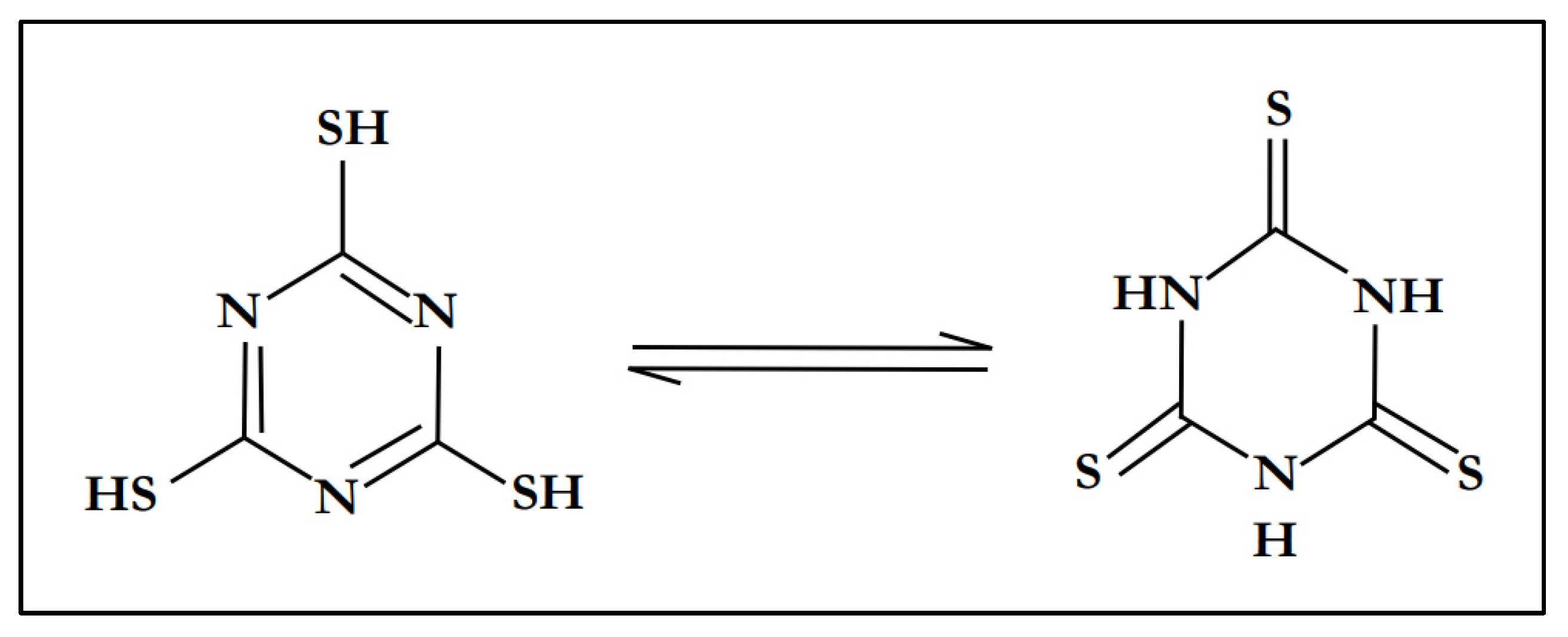


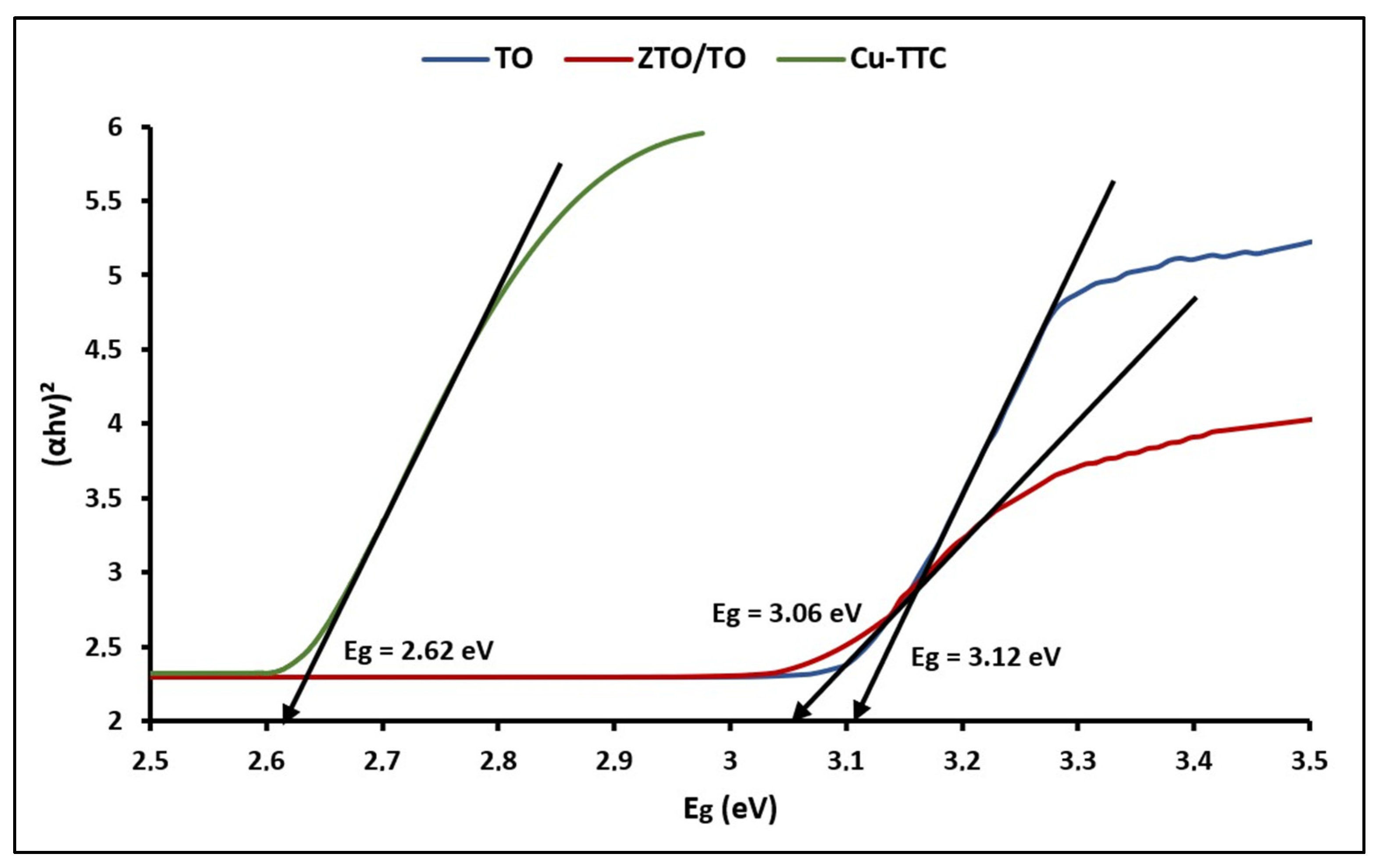
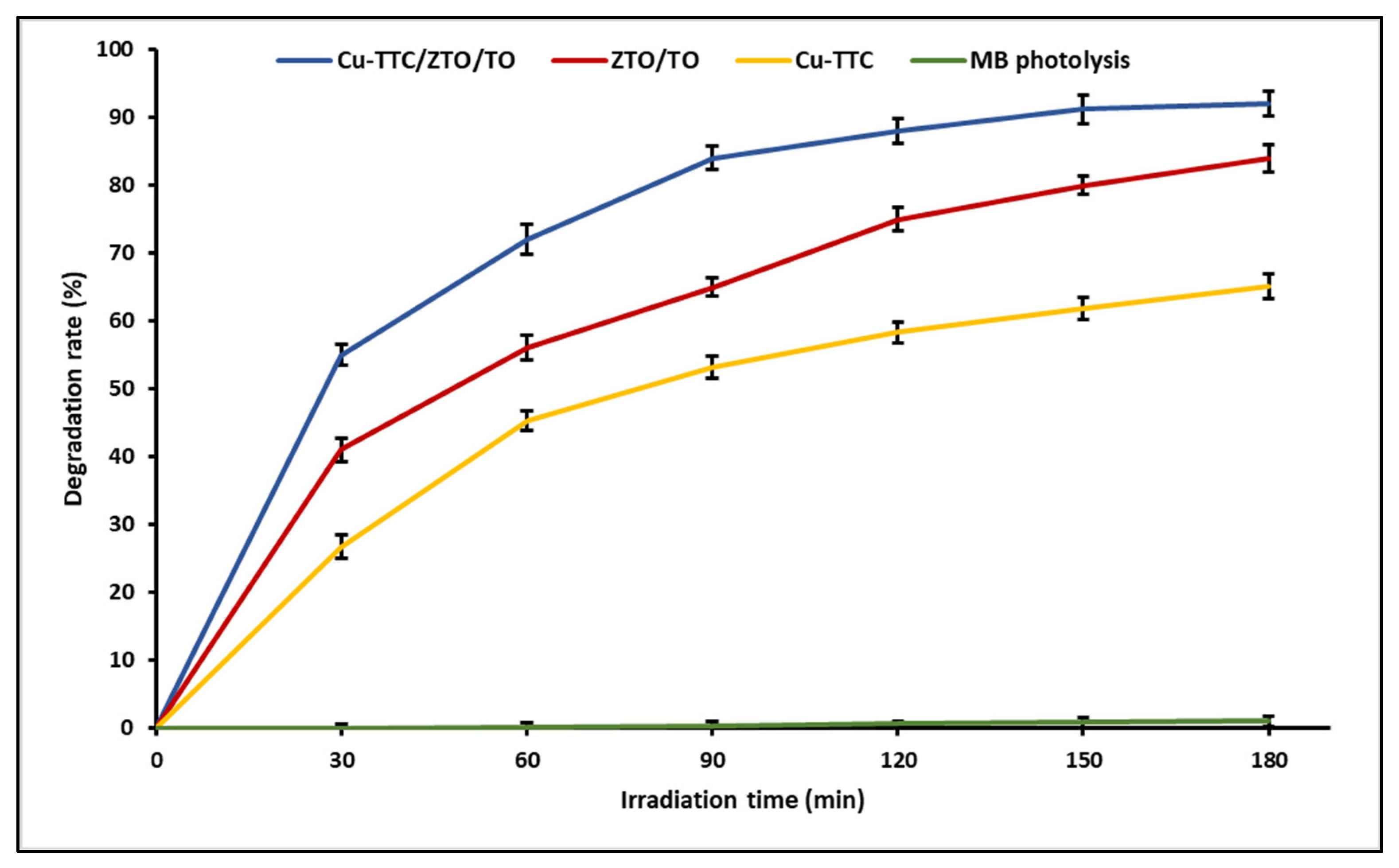
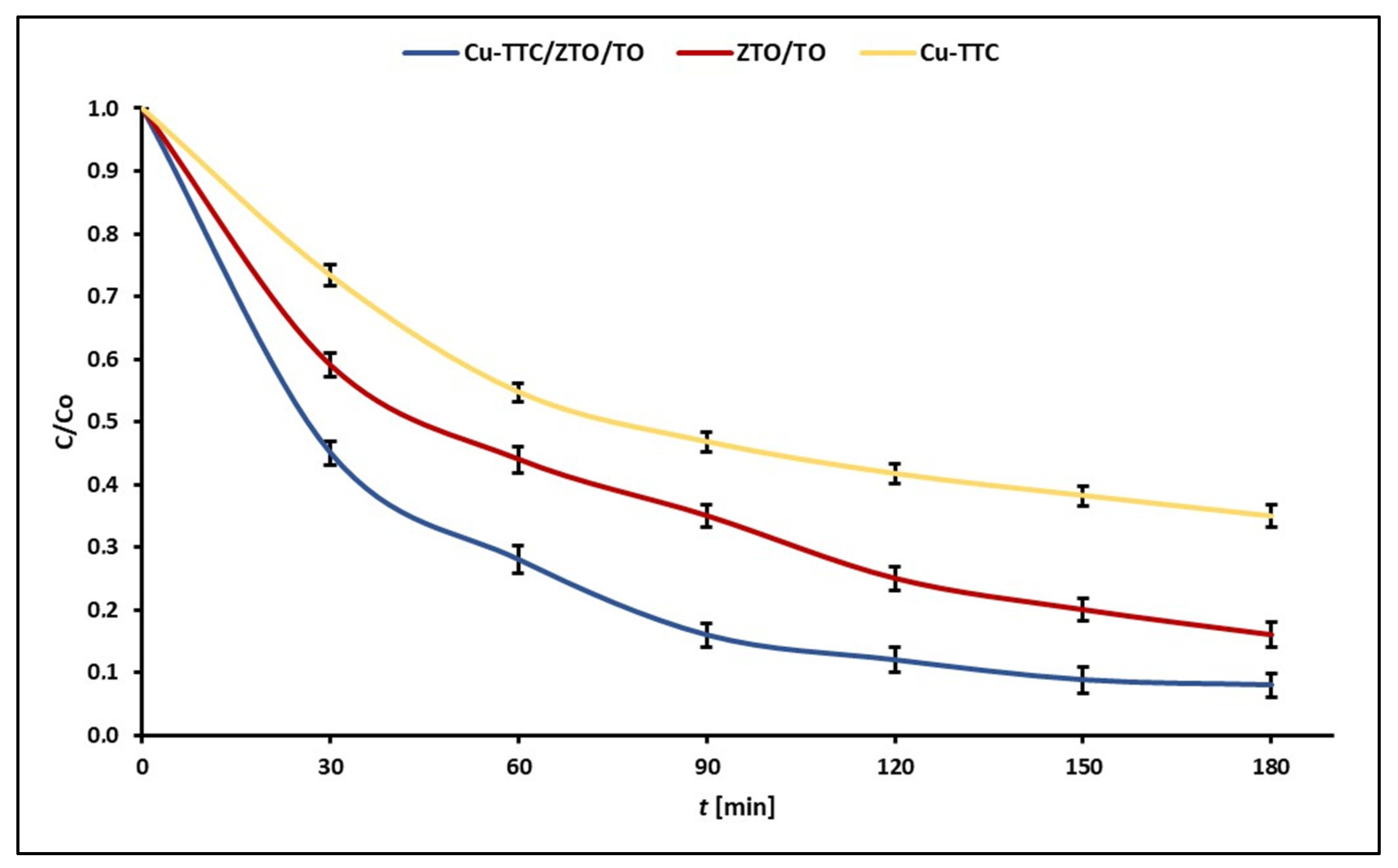
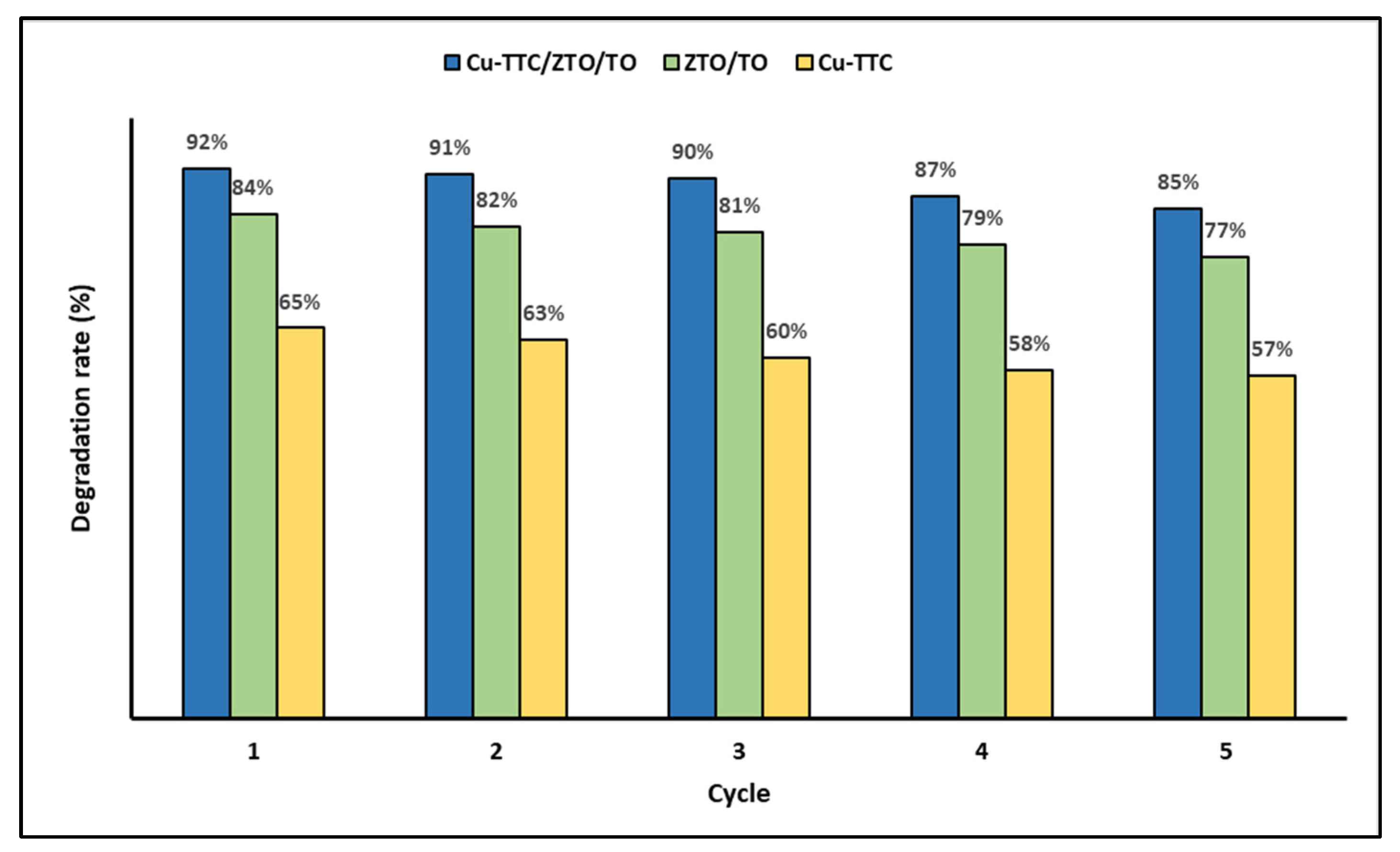
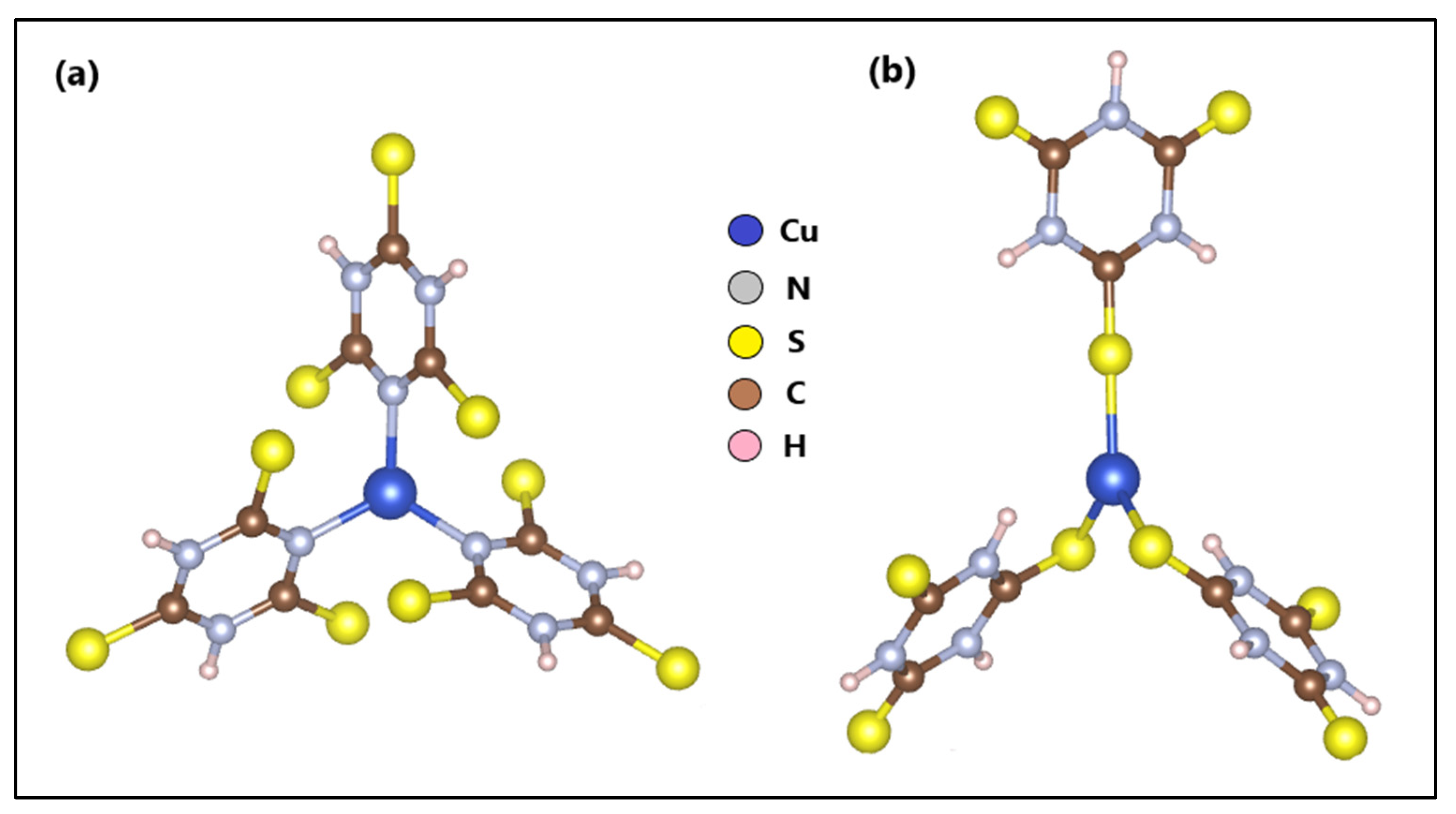

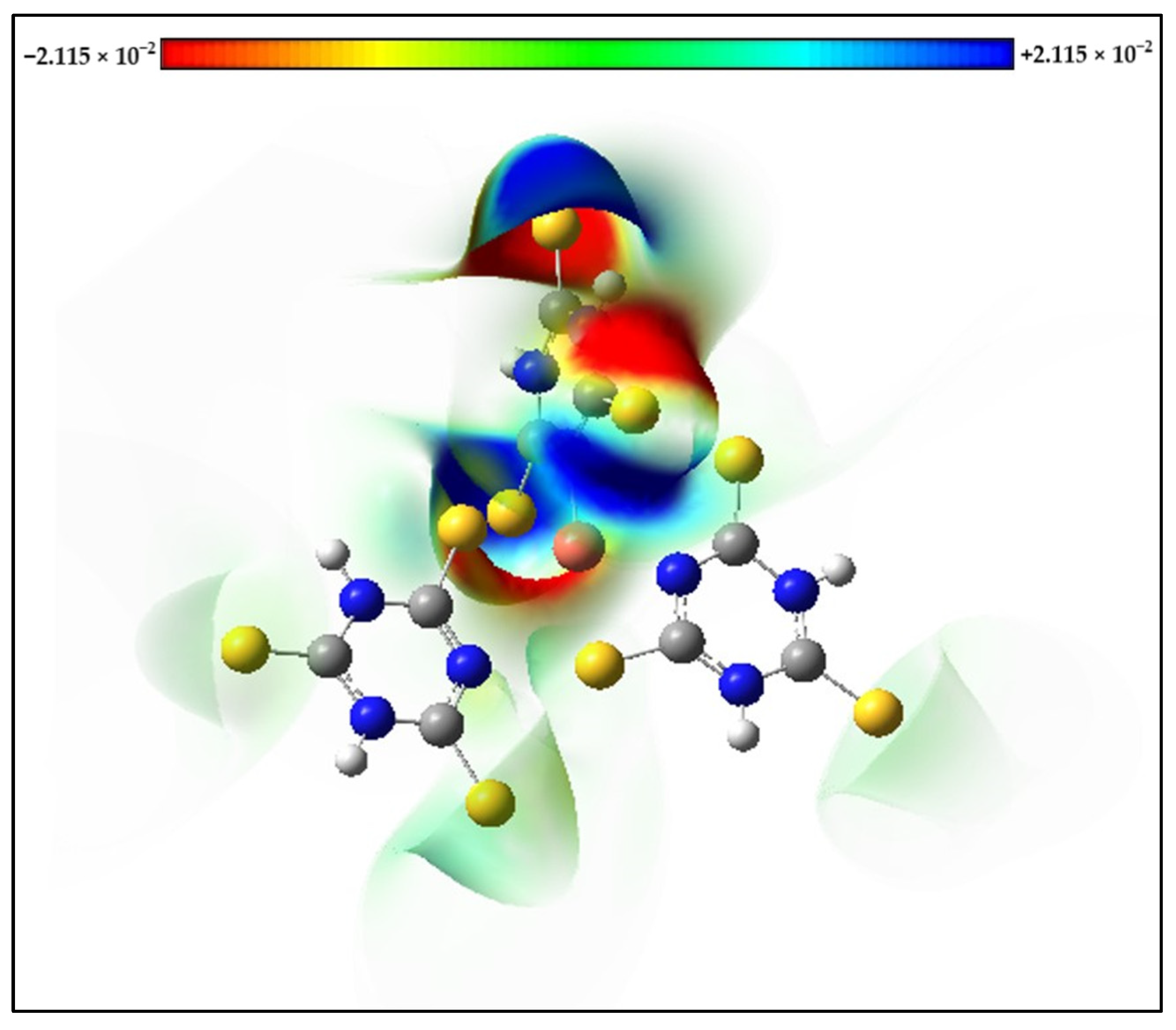
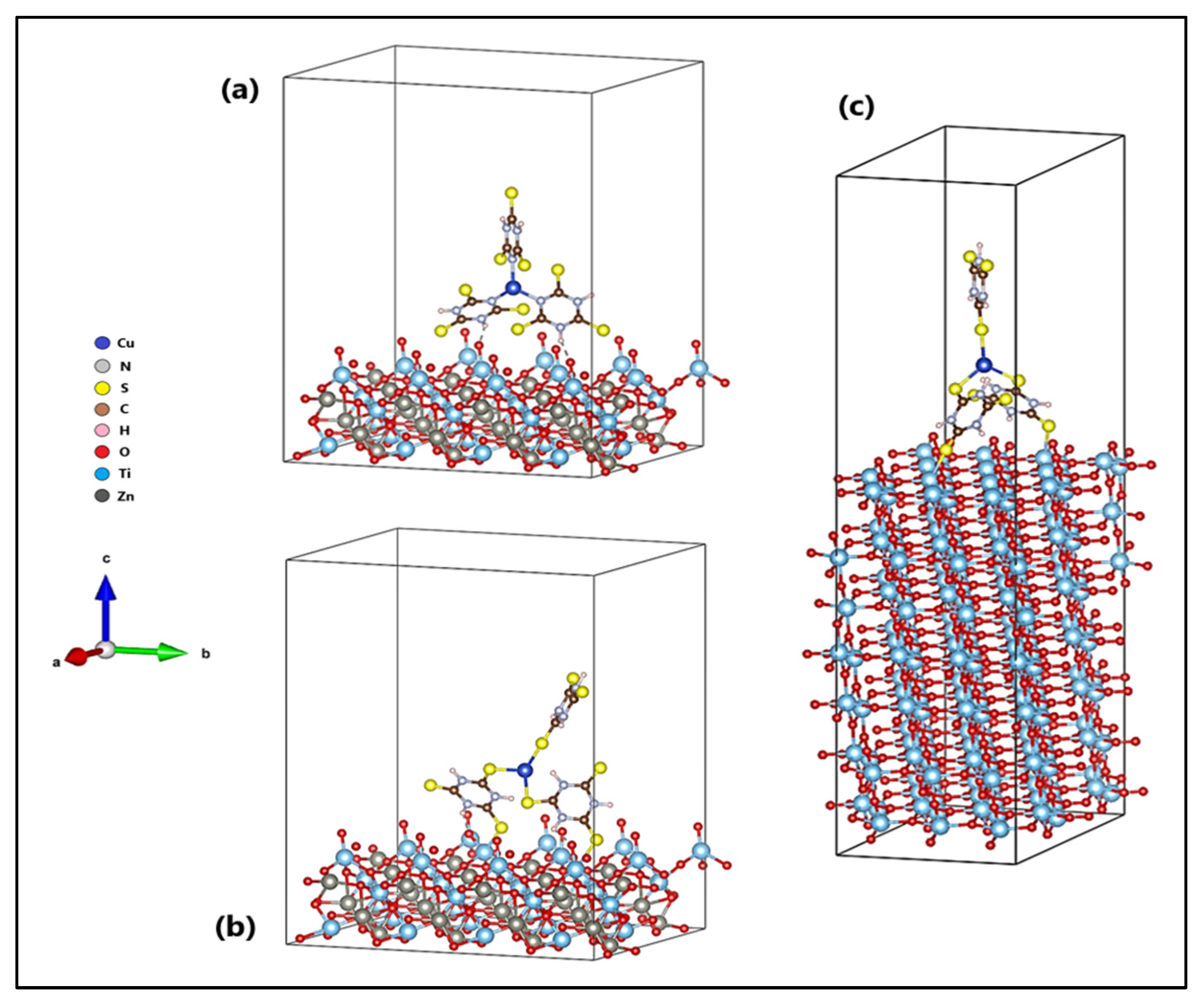

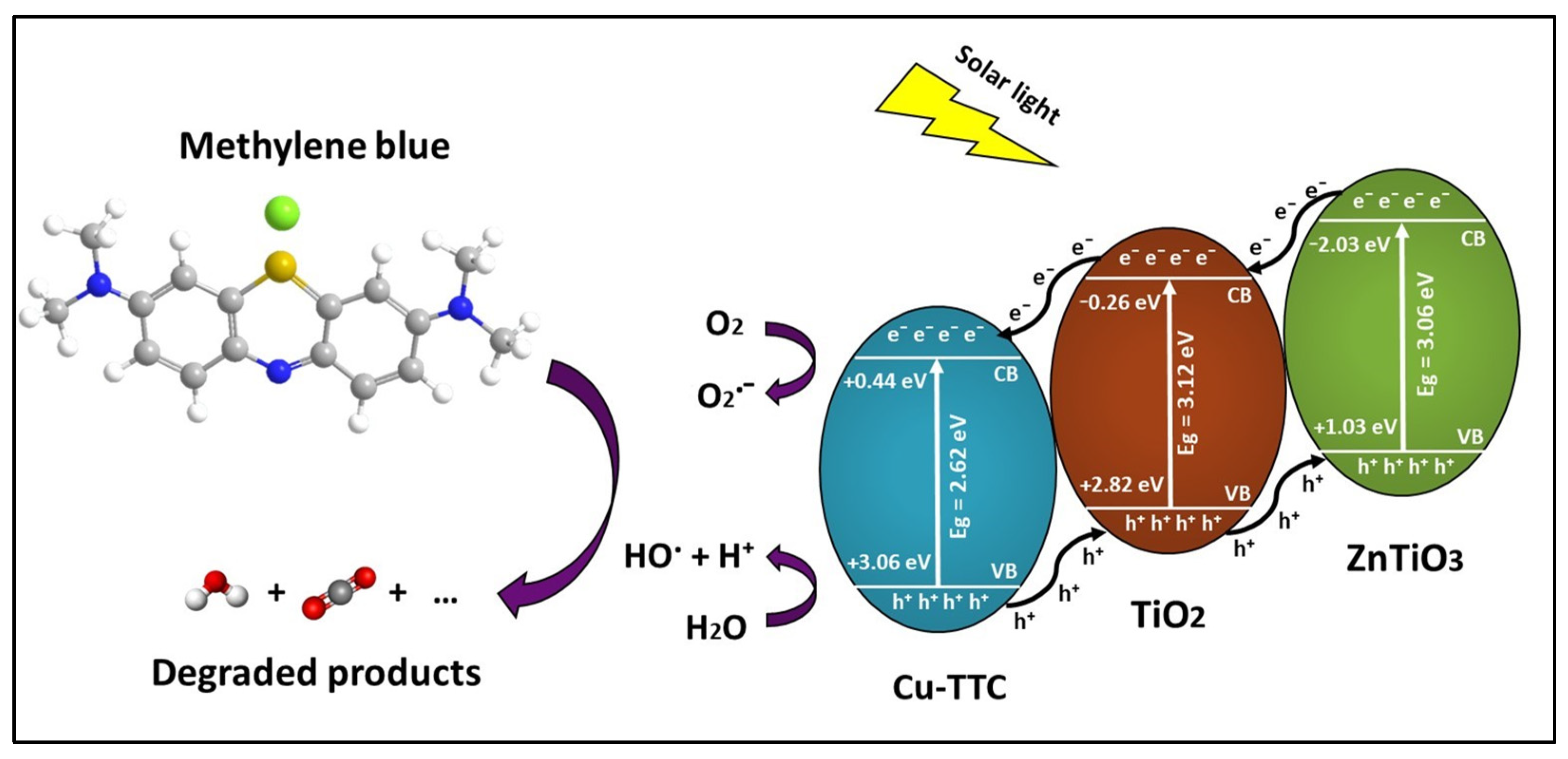
| ZTO/TO | Cu-TTC/ZTO/TO | Cu-TTC | |
|---|---|---|---|
| kapp (min−1) | 9.8 × 10−3 (±5.1 × 10−5) | 1.4 × 10−2 (±4.1 × 10−4) | 5.6 × 10−3 (±3.9 × 10−4) |
| R2 | 0.96 | 0.95 | 0.93 |
| χ2 | 1.5 × 10−3 | 2.3 × 10−2 | 1.8 × 10−3 |
| Specifications | Results | Results |
|---|---|---|
| File Name | n-Cu-TTC | s-Cu-TTC |
| Calculation Method | RB3LYP | RB3LYP |
| Basis Set | TZV | TZV |
| Charge | 0 | 0 |
| Spin | Singlet | Singlet |
| E(UB3LYP) (a.u.) | −6063.7277 | −6063.7287 |
| RMS Gradient Norm (a.u.) | 0.00000911 | 0.00000782 |
| Imaginary Freq | 0 | 0 |
| Dipole Moment (Debye) | 2.4997 | 3.0174 |
| Point Group | C1 | C1 |
| n-Cu-TTC | s-Cu-TTC | |
|---|---|---|
| EHOMO (eV) | −6.67 | −6.71 |
| ELUMO (eV) | −5.83 | −5.89 |
| Electronegativity | 6.25 | 6.30 |
| Adsorbent (Surface) | Dye | Software Used | Adsorption | References | |
|---|---|---|---|---|---|
| eV | kJ/mol | ||||
| TiO2 (101) | R4-BT | VASP | −1.40 | −135.46 | [58] |
| TiO2 (101) | R4-F2BT | VASP | −1.39 | −134.50 | [58] |
| TiO2 (101) | R4-BO | VASP | −1.39 | −134.50 | [58] |
| TiO2 (101) | R6-Bz | VASP | −1.40 | −135.46 | [58] |
| TiO2 (101) | R6-BT | VASP | −1.38 | −133.53 | [58] |
| TiO2 (101) | R6-F2BT | VASP | −1.37 | −132.56 | [58] |
| TiO2 (101) | R6-B0 | VASP | −1.37 | −132.56 | [58] |
| TiO2 (101) | R6-Bz | VASP | −1.38 | −133.53 | [58] |
| TiO2 (101) | MB | VASP | −0.12 | −11.61 | [63] |
| TiO2 (101) | s-Cu-TTC | VASP | −1.21 | −116.95 | This study |
| ZnTiO3 (101) | TPA-1 | CASTEP | −1.41 | −136.39 | [66] |
| ZnTiO3 (101) | TPA-2 | CASTEP | −1.63 | −157.47 | [66] |
| ZnTiO3 (101) | TPA-3 | CASTEP | −5.82 | −561.33 | [66] |
| ZnTiO3 (101) | TPA-4 | CASTEP | −2.37 | −228.19 | [66] |
| ZnTiO3(H) (101) | MB | VASP | −1.31 | −126.76 | [63] |
| ZnTiO3(SP) (101) | MB | VASP | −2.92 | −282.05 | [63] |
| ZnTiO3 (101) | s-Cu-TTC | VASP | −3.07 | −296.56 | This study |
Publisher’s Note: MDPI stays neutral with regard to jurisdictional claims in published maps and institutional affiliations. |
© 2022 by the authors. Licensee MDPI, Basel, Switzerland. This article is an open access article distributed under the terms and conditions of the Creative Commons Attribution (CC BY) license (https://creativecommons.org/licenses/by/4.0/).
Share and Cite
Jaramillo-Fierro, X.; Hernández, K.; González, S. Cu(C3H3N3S3)3 Adsorption onto ZnTiO3/TiO2 for Coordination-Complex Sensitized Photochemical Applications. Materials 2022, 15, 3252. https://doi.org/10.3390/ma15093252
Jaramillo-Fierro X, Hernández K, González S. Cu(C3H3N3S3)3 Adsorption onto ZnTiO3/TiO2 for Coordination-Complex Sensitized Photochemical Applications. Materials. 2022; 15(9):3252. https://doi.org/10.3390/ma15093252
Chicago/Turabian StyleJaramillo-Fierro, Ximena, Karol Hernández, and Silvia González. 2022. "Cu(C3H3N3S3)3 Adsorption onto ZnTiO3/TiO2 for Coordination-Complex Sensitized Photochemical Applications" Materials 15, no. 9: 3252. https://doi.org/10.3390/ma15093252
APA StyleJaramillo-Fierro, X., Hernández, K., & González, S. (2022). Cu(C3H3N3S3)3 Adsorption onto ZnTiO3/TiO2 for Coordination-Complex Sensitized Photochemical Applications. Materials, 15(9), 3252. https://doi.org/10.3390/ma15093252








